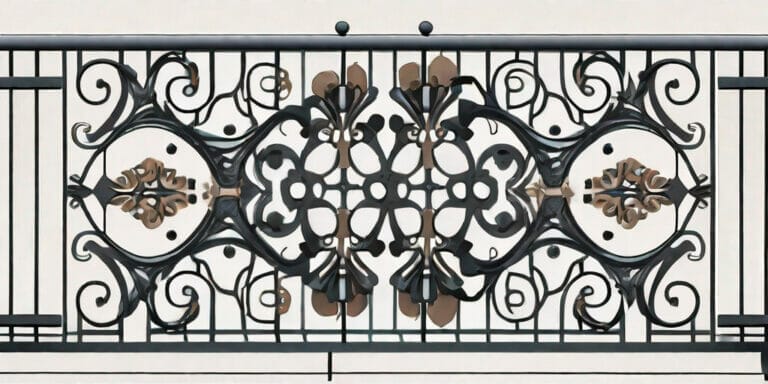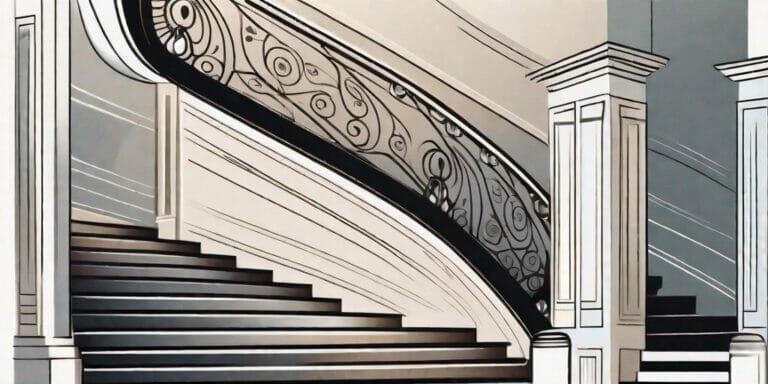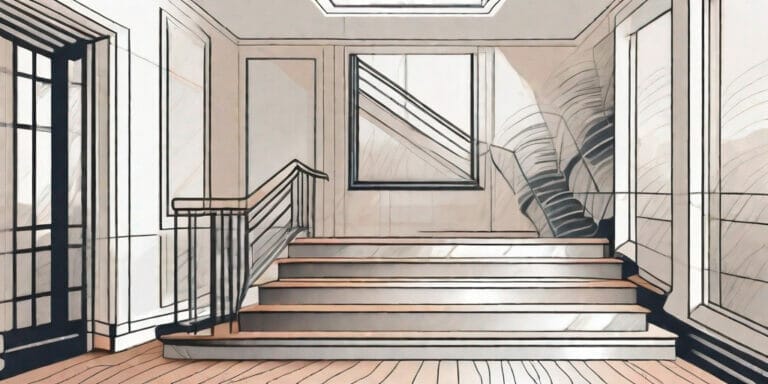Stair railings not only serve as a safety feature, but also add a touch of style and elegance to any staircase. Whether it’s for indoor or outdoor use, modern or traditional designs, there are countless options available to suit every taste and budget. In this article, we will explore the different types of stair railings, the benefits of installing one, and the steps involved in the installation process.
Types of Stair Railings
When it comes to stair railings, the options are vast. From classic wooden railings to sleek metal designs, there is something to match every aesthetic. Let’s take a closer look at some of the most popular types:
Indoor Stair Railings
Indoor stair railings are typically made from wood, iron, or a combination of both. These railings not only provide safety but also enhance the overall look and feel of your interior decor. From simple and understated designs to ornate and intricate ones, indoor stair railings can be customized to reflect your personal style.
Wooden indoor stair railings offer a timeless and traditional charm. They can be crafted from various types of wood, such as oak, maple, or mahogany, each with its own unique grain patterns and colors. Wooden railings can be stained or painted to match your interior color scheme, and they can be carved with intricate details for a more elaborate look.
Iron indoor stair railings, on the other hand, bring a touch of elegance and sophistication to any space. They can be designed with intricate scrollwork, geometric patterns, or even incorporate decorative elements like leaves or flowers. Iron railings can be left in their natural state for a rustic appeal or painted in any color to match your interior design.
Modern Stair Railing
If your home features a contemporary or minimalist design, a modern stair railing is the perfect choice. These railings often incorporate sleek lines, glass panels, and metal accents to create a clean and sophisticated look. With endless design possibilities, a modern stair railing can become a focal point of your home.
Glass panels are a popular choice for modern stair railings as they create a sense of openness and allow light to pass through, making the staircase appear more spacious. The glass can be clear, frosted, or even patterned for added visual interest. Metal accents, such as stainless steel or brushed nickel, can be used to frame the glass panels or as handrail supports, adding a touch of industrial chic to the overall design.
Stair Handrail
Stair handrails are an essential safety feature for any staircase. They provide stability and support while ascending or descending the stairs, especially for those with mobility issues. Stair handrails can be designed to blend seamlessly with the overall railing or stand out as a separate element, depending on your preference.
Handrails can be made from the same material as the stair railing for a cohesive look, or they can be a contrasting element to create visual interest. For example, if you have a wooden stair railing, you can opt for a metal handrail to add a modern touch. Handrails can also be curved or straight, depending on the design of the staircase, and they can be adorned with decorative finials or end caps for a refined finishing touch.
Metal Stair Railing
Metal stair railings offer durability, strength, and a sleek appearance. With materials like wrought iron, stainless steel, or aluminum, these railings are built to withstand heavy usage and adverse weather conditions. Metal stair railings can be customized with various finishes and design elements to create a unique and eye-catching look.
Wrought iron railings are known for their intricate designs and ornate details. They can be crafted into elaborate scrollwork, floral motifs, or even depict animals or mythological figures. Stainless steel railings, on the other hand, have a more contemporary and minimalist aesthetic. They can be polished to a high shine or given a brushed finish for a sleek and modern look. Aluminum railings are lightweight yet sturdy, making them a popular choice for outdoor stair railings.
Outdoor Stair Railings
Outdoor stair railings are exposed to the elements and require materials that can withstand harsh weather conditions. From wood to metal to vinyl, outdoor railings can be designed to complement the exterior of your home while providing safety and functionality. Choosing the right materials for outdoor railings is crucial to ensure longevity and minimize maintenance.
Wooden outdoor stair railings can be treated with weather-resistant stains or paints to protect them from moisture, UV rays, and insects. They can be designed to match the architectural style of your home, whether it’s a cozy cottage or a modern farmhouse. Metal outdoor railings, such as wrought iron or aluminum, are naturally resistant to rust and corrosion, making them ideal for outdoor use. Vinyl railings, on the other hand, are low-maintenance and can withstand extreme temperatures without warping or fading.
Consider the climate and overall aesthetic of your outdoor space when choosing the material for your stair railing. A well-designed outdoor stair railing not only enhances the safety of your staircase but also adds curb appeal and value to your home.
Costs of Installing a Stair Railing
The cost of installing a stair railing can vary greatly depending on a multitude of factors. While it is true that the type of materials used, the complexity of the design, and the size of the staircase all play a role in determining the overall cost, there are several other considerations that homeowners should keep in mind when budgeting for this project.
One important factor to consider is the location of the staircase within the home. If the staircase is located in a high-traffic area or serves as a focal point of the house, homeowners may want to invest in a more elaborate and visually appealing railing design. This could include ornate ironwork, intricate wood carvings, or even a combination of different materials to create a unique and eye-catching look. However, these custom designs often come with a higher price tag due to the additional time and craftsmanship required.
In addition to the design, the choice of materials can significantly impact the cost of installing a stair railing. While traditional materials such as wood and wrought iron are popular choices, there are now a wide variety of options available on the market. For example, homeowners can choose from stainless steel, glass, cable, or even composite materials. Each material has its own unique qualities and price points, so it’s important to carefully consider the desired aesthetic, durability, and maintenance requirements when making a selection.
Furthermore, the size and complexity of the staircase itself can also affect the cost of installation. A standard, straight staircase with a simple railing design will generally be less expensive to install compared to a curved or spiral staircase. The additional labor and materials required to accommodate these unique designs can quickly add up.
It’s also worth noting that the cost of installing a stair railing may vary depending on the region and local market conditions. In areas with a higher cost of living or a shortage of skilled labor, homeowners can expect to pay more for installation services. Conversely, in areas where competition is high, prices may be more competitive.
While the average cost of installing a standard stair railing typically falls between $1,000 and $5,000, it’s important for homeowners to obtain multiple quotes from reputable contractors to get an accurate estimate for their specific project. By considering all of the aforementioned factors and conducting thorough research, homeowners can make an informed decision and ensure that their new stair railing not only meets their aesthetic preferences but also fits within their budget.
Benefits of Installing a Stair Railing
Installing a stair railing offers numerous benefits beyond safety. Here are some compelling reasons to consider adding a railing to your staircase:
- Safety: A stair railing provides stability and support, reducing the risk of falls and accidents.
- Enhanced Aesthetics: A well-designed stair railing adds visual appeal and can complement the overall decor of your home.
- Increased Property Value: Installing a stair railing can boost the value of your home, as it is often considered a desirable feature by potential buyers.
- Code Compliance: In many jurisdictions, building codes require the installation of stair railings for safety reasons. Compliance with these regulations ensures that your home meets the necessary standards.
Steps for Installing a Stair Railing
While it is always recommended to hire a professional for the installation of a stair railing, here are the general steps involved in the process:
- Measure and Plan: Accurately measure the dimensions of your staircase and determine the style and material of the railing you want to install.
- Prepare the Area: Clean the staircase and ensure it is free from any obstructions or debris.
- Attach the Mounting Brackets: Install the mounting brackets or posts securely to provide a stable base for the railing.
- Assemble the Railing: If your railing comes in separate parts, follow the manufacturer’s instructions to assemble it correctly.
- Secure the Railing: Attach the railing to the mounting brackets or posts, ensuring it is level and secure.
- Finishing Touches: Apply any necessary coatings or finishes to protect the railing and enhance its appearance.
Advantages of Steel Stair Railings
Steel stair railings offer several advantages that make them a popular choice among homeowners. Here are some reasons why steel railings are worth considering:
- Durability: Steel is highly resistant to wear and tear, making it a long-lasting option for stair railings.
- Strength: Steel railings provide excellent structural support, ensuring the safety and stability of your staircase.
- Customization: Steel can be easily shaped and molded into various designs, allowing for endless possibilities when it comes to customization.
- Low Maintenance: Unlike wood, steel does not require regular staining or sealing. Simple cleaning with soap and water is usually sufficient to keep it looking its best.
Whether you’re looking to enhance the safety of your staircase or add a stylish element to your home’s interior or exterior, a stair railing is a worthwhile investment. With countless design options and materials available, finding the perfect railing to suit your needs and preferences has never been easier. So, take the first step towards transforming your staircase and enjoy the beauty and peace of mind that a well-designed stair railing provides.






